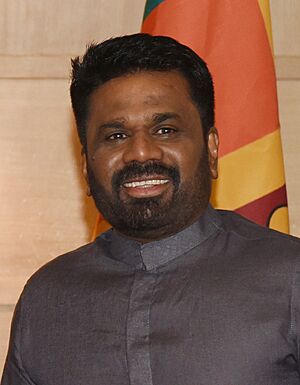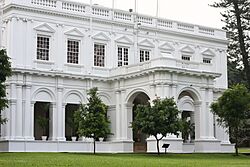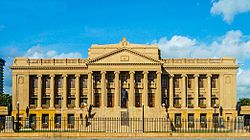President of Sri Lanka facts for kids
Quick facts for kids President of Sri Lanka |
|
|---|---|

|
|

Emblem of Sri Lanka
|
|
| Style |
|
| Member of | Cabinet National Security Council |
| Residence | President's House |
| Nominator | Citizens of Sri Lanka |
| Appointer | Direct election |
| Term length | Five years,
renewable once
|
| Constituting instrument | Constitution of Sri Lanka (1978) |
| Precursor | Monarch of Ceylon |
| Inaugural holder | William Gopallawa under the 1972 Constitution |
| Formation | 22 May 1972 |
| First holder | William Gopallawa |
| Succession | Sri Lankan presidential line of succession |
| Deputy | Prime Minister |
| Website | |
The President of Sri Lanka is the main leader of the country. This person is both the head of state (the symbolic leader) and the head of government (the one who runs the country). The President is also the top commander of Sri Lanka's armed forces.
The President chooses the Prime Minister of Sri Lanka, who must have the support of the Parliament of Sri Lanka.
Anura Kumara Dissanayake is the current President. He became the 10th President on September 23, 2024, after winning the 2024 Sri Lankan presidential election.
Contents
History of the Presidency
From Monarchy to Republic
Before 1972, Sri Lanka was called Ceylon. It was a constitutional monarchy, meaning it had a king or queen (the monarch of Ceylon) as the head of state, but a Prime Minister ran the government. The monarch was represented by a Governor-General in Sri Lanka.
In 1972, Sri Lanka became a parliamentary republic with a new constitution. At this time, the President was mostly a ceremonial figure, like a symbol for the country. The Prime Minister still held most of the real power.
The Executive Presidency
In 1978, a big change happened. The constitution was updated, making the President a very powerful leader. This new "executive presidency" was similar to the French system. The President became both the head of state and the head of government. They also became the commander-in-chief of the armed forces and led the cabinet of ministers. The President could even dissolve (end) Parliament and call for new elections. The Prime Minister's role became more of an assistant and deputy to the President.
Changes to Presidential Powers
Over the years, there have been several changes to the President's powers:
- The 17th Amendment (2001) reduced some of the President's powers, especially regarding who could be appointed to high judicial positions and independent groups like the election commission.
- The 18th Amendment (2010) removed the limit on how many terms a President could serve. This meant a President could run for office many times. It also increased the President's power by changing a broad council into a smaller parliamentary one.
- The 19th Amendment (2015) reversed many of the changes from the 18th Amendment. It brought back the two-term limit for the President. It also required the President to talk with the Prime Minister about choosing ministers. This amendment also made the President less immune from legal action for official acts.
- In 2022, Sri Lanka faced a big economic crisis. This led to large protests where people demanded changes, including reducing the President's powers. After the then-President resigned, the Prime Minister was elected President by Parliament.
- The 21st Amendment (2022) was introduced to give more power back to the Parliament and reduce some of the President's powers. Under this amendment, the President, Cabinet, and National Council are all answerable to Parliament. It also stopped people with dual citizenship (citizenship in two countries) from running in elections.
How the President is Chosen
Who Can Be President?
To become President of Sri Lanka, a person must:
- Be a citizen of Sri Lanka.
- Be nominated by a recognized political party or be an elected member of the legislature.
- Not have been elected President twice before by the people.
- Only hold Sri Lankan citizenship.
Presidential Elections
The President is elected by people across the country for a five-year term. A President can serve a maximum of two terms.
Sri Lanka uses a special system for voting called ranked voting. Voters can choose up to three candidates in order of their preference. If no candidate gets more than half of the votes in the first count, the candidates with the fewest votes are removed. Their second and third choice votes are then given to the remaining top two candidates until one person gets more than 50% of the votes.
A President can decide to call an early election for their second term after four years of their first term.
What Happens if the President's Office is Empty?
If the President cannot do their job because of death, resignation, or removal from office, the Prime Minister temporarily takes over.
If the President's office becomes permanently empty before their term ends, Parliament chooses one of its members to be the new President. This new President only serves for the rest of the original term. Until a new President is chosen, the Prime Minister acts as the Acting president.
This has happened twice:
- In 1993, after President Premadasa was assassinated, Prime Minister D. B. Wijetunga became President.
- In 2022, after President Rajapaksa resigned, Prime Minister Ranil Wickremesinghe was elected President.
How Long Does a President Serve?
When the office was first created in 1972, the President's term was six years. After the executive presidency started in 1978, the President was elected by popular vote for six years and could serve two terms.
The 19th Amendment changed the term length to five years. A President can still call an early election for their second term after four years.
If someone becomes President because the previous President left office early, they only serve for the remaining time of the original term. They cannot call an early election.
What the President Does
Main Duties
The President's main duties include:
- Making sure the Constitution is followed.
- Helping the country unite and heal.
- Ensuring that important councils and institutions work properly.
- Working with the Election Commission to make sure elections are fair.
Powers of the President
The President has many powers:
- They are responsible to Parliament and can be removed by a two-thirds vote in Parliament.
- They can declare war or peace.
- They can declare a state of emergency in the country, which gives them special powers to make rules without Parliament's approval. However, Parliament must approve if the emergency lasts longer than six months.
- They can dismiss national or state governments if there is corruption, treason, or if they cannot govern.
Working with Parliament
The President can attend Parliament every three months but does not vote. They can also speak to Parliament or send messages, and they can call, suspend, or dissolve Parliament.
Appointing People
The President appoints many important people, including:
- The Prime Minister.
- Ministers for the cabinet and other roles.
- Provincial governors.
- Public officers and ambassadors.
- Officers in the armed forces.
- Secretaries and staff.
Judicial Powers
The President appoints and can remove top judges, including the Chief Justice and judges of the Supreme Court, Court of Appeal, and High Court. The President can also grant pardons (forgive people for crimes). The President is usually protected from civil and criminal lawsuits while in office. They can also set up public investigations into any issue.
Diplomatic Powers
The President is Sri Lanka's main diplomat. They are in charge of talking with leaders of other countries and appointing ambassadors.
Ceremonial Roles
The President has important ceremonial duties, like leading state ceremonies and giving out national awards. They give a traditional "throne speech" to Parliament, explaining the government's plans. They also lead Independence Day celebrations and other national events.
Other Appointments
The President can appoint provincial governors to lead provincial councils. They can also appoint many "presidential advisers" and coordinating secretaries to help them.
The President can appoint senior lawyers as "President's Counsel." They can also appoint military officers as their personal assistants (aide-de-camp) and medical officers as honorary physicians or surgeons.
Presidential Benefits
Salary
As of 2016, the President receives a monthly salary of LKR 100,000 (about $1,000 USD). This was increased in 2006.
Tax Benefits
Traditionally, the President and former Presidents did not pay income tax. However, this changed in 2018 with a new law, so now the President does pay taxes.
Legal Protection
The President is protected from civil or criminal lawsuits while they are in office and for actions taken during their term.
Homes
The President's official home in Colombo is the President's House. The government pays for meals and staff there. Other official homes include:
- The President's Pavilion in Kandy.
- The Queen's Cottage in Nuwara Eliya, used for vacations.
Some Presidents have chosen to live in the Prime Minister's official residence, Temple Trees, or even their own private homes.
Travel
For travel on the ground, the President uses a special armored black Mercedes-Benz S-Class car. For air travel within Sri Lanka, helicopters from the Sri Lanka Air Force are used. For international travel, special or regular flights from Sri Lankan Airlines are used. For ceremonial events, ships from the Sri Lanka Navy can be used as a "presidential yacht."
Security
The President's Security Division (PSD) protects the President. In the past, a special Army unit called the 'President's Guard' was formed for this purpose. However, in April 2015, this unit was dissolved. Currently, the President's security is provided by the elite Special Task Force (STF) of the Sri Lanka Police.
Presidential Flag (1972−2022)
Each President used to have their own unique flag, which was a symbol of their office. These flags often included traditional symbols related to the President or their home area. However, the presidential flag was abolished by the Acting President in 2022.
Presidential Dispatch Bag
The 'Attaché Case' or Presidential Dispatch Bag is a special bag that carries important and secret documents for the President. It was designed by the Sri Lanka Army. This bag is passed from one President to the next.
Presidential Staff
Presidential Secretariat
The Presidential Secretariat is the government office that supports the President. It handles the President's administrative tasks and other government roles the President holds. It is located in the former Parliament building in Colombo. The most senior civil servant in the country, the Secretary to the President, leads it.
Presidential Advisers
The President can appoint many people as "presidential advisers" to help them. The highest-ranking ones are called "senior advisers."
Chief of Staff
The chief of staff is the highest-ranking person who manages the President's staff. This position is currently vacant since President Dissanayake took office in 2024.
Coordinating Secretaries
The President can also appoint "coordinating secretaries" to help them.
The President's Fund
The President leads the Board of Governors for the President's Fund. This fund was set up in 1978 to help people in need, provide special healthcare, support education, promote religion and culture, give awards to people who have served the nation, and for other public benefits. The Presidential Secretariat manages it.
After Being President
Pension
Former Presidents receive a pension equal to their last salary while in office. This pension is paid from government funds and is in addition to any other pension they might receive from previous jobs. The widow of a former President also receives a monthly pension.
Other Benefits
According to a 1986 law, a former President or their widow is entitled to an official residence. A former President also receives a monthly allowance for secretarial help, equal to the salary of a private secretary to a cabinet minister. They also get official transport and other benefits similar to a cabinet minister.
Order of Importance
A former President or their widow is ranked at the same level as a cabinet minister in the official order of importance.
Staying in Politics
Even after their term as President ends, former Presidents can still be involved in politics. For example, Mahinda Rajapaksa continued to serve as a Member of Parliament and even as Prime Minister after his presidency.
See also
 In Spanish: Presidente de Sri Lanka para niños
In Spanish: Presidente de Sri Lanka para niños
- List of presidents of Sri Lanka
- Prime Minister of Sri Lanka
- Presidential Secretariat
- President's Security Division
- President's Guard
- Official state car of the president of Sri Lanka
- Air transports of heads of government of Sri Lanka




